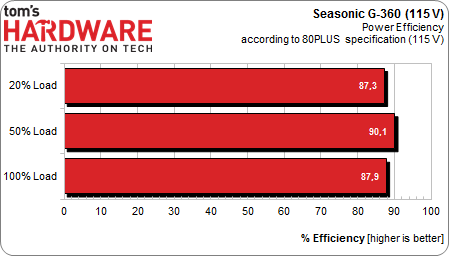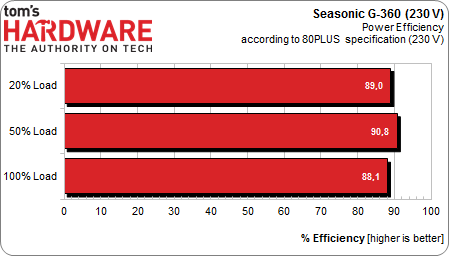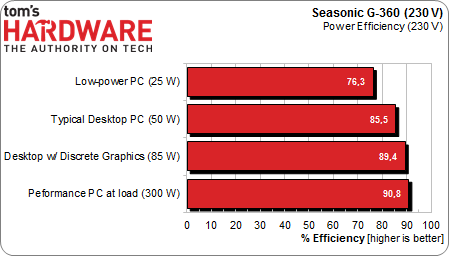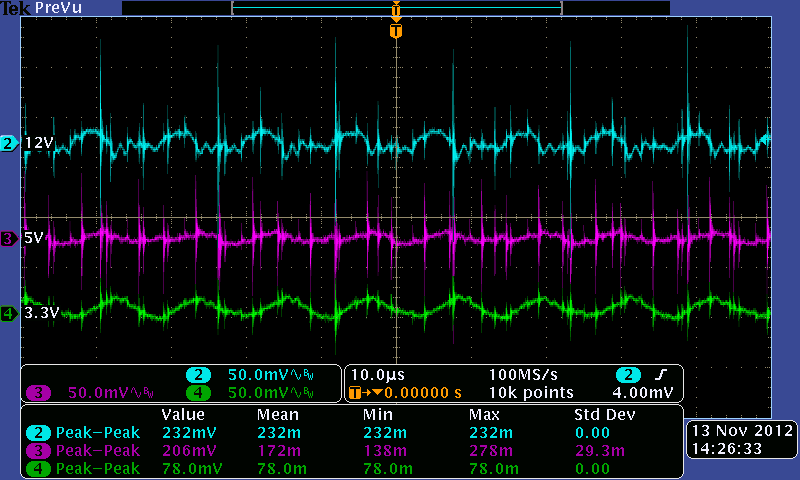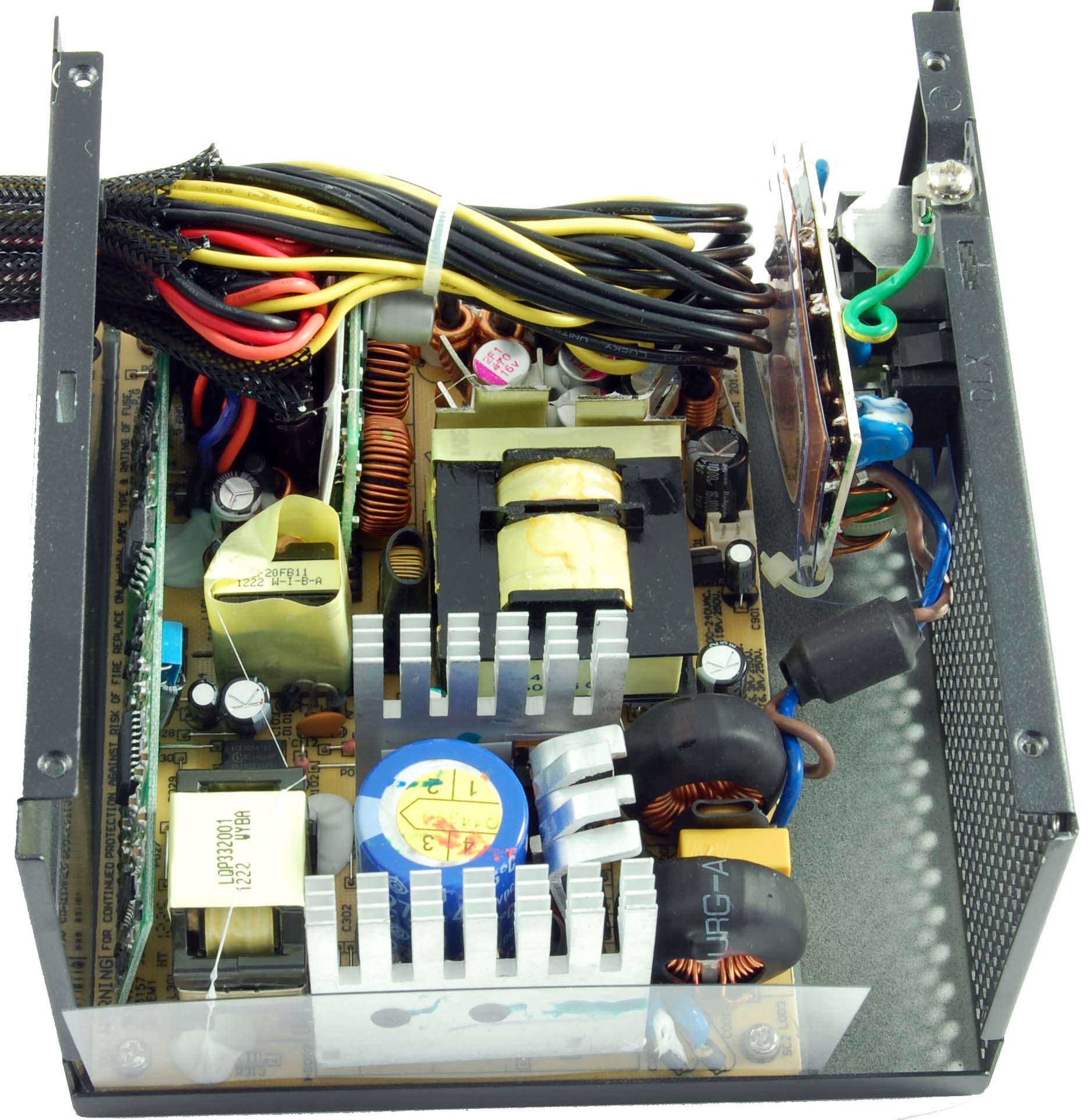Part 2: Four Cheap 80 PLUS Bronze Power Supplies, Reviewed
Ready for part two of our low-cost power supply round-up? Here are four more products, including Seasonic's SSR-360GP, which is 80 PLUS Gold-certified. Is this little 360 W PSU the bargain of the century, or is its Gold label simply pyrite?
Seasonic SSR-360GP: Measurements
Efficiency According to the 80 PLUS Spec
Efficiency by Load
Proudly displaying the 80 PLUS Gold logo on its box, Seasonic's SSR-360GP has something that no other power supply in our two-part round-up offers, and we're eager to test it. The efficiency requirements are significantly higher for a Gold-certified PSU than the Bronze-rated ones. For all three load scenarios, the efficiency minimums to qualify for 80 PLUS Gold are five percentage points higher, in fact. And Seasonic's SSR-360GP satisfies those stringent requirements without a problem. At 20% and 50% of its maximum load, the supply complies with little leeway to spare, while its efficiency at full load is noticeably better than the Gold tier's requirement. Seasonic extends its 5% advantage over the other PSUs even into low-load conditions. At 25 W, its efficiency is an admirable 75%.
The scope picture again reveals spikes that seem to plague all of the lower-end PSUs in our round-up. If we take them into account, all of Seasonic's DC rails would violate the ATX spec. But because we're looking past them, the waveforms look OK, if not a little more jagged than we'd expect. The SSR-360GP passes all other tests without a problem. It is also barely audible. We measured 30.2 dB(A) at 40 W and 30.6 dB(A) at 200 W; you'd only hear that with an ear close to the power supply.
A Close Look at the PCB
Building an 80 PLUS Gold-rated PSU to sell at $60 is quite a challenge, even for a company like Seasonic, since the high-quality parts are more expensive. Thus, money has to be saved elsewhere. For instance, we notice that the SSR-360GP's soldering quality, while OK, does not approach what you'd find on the company's flagship X-series. However, the electrical design is still quite modern, utilizing a DC-DC converter and an LLC resonance converter. Almost all capacitors are made in Japan. We found capacitors from Hitachi, Chemi-Con, and Rubycon. A few capacitors are made by Korea-based Enesol. All necessary components are there, and the component layout looks nice.
Get Tom's Hardware's best news and in-depth reviews, straight to your inbox.
Current page: Seasonic SSR-360GP: Measurements
Prev Page Seasonic SSR-360GP Next Page Test Configuration, Hold-Up Time, And Inrush Current-
pepsimtl Please, if you could say , if the power supply is compatible with Haswell .I think this is very important .Reply -
jeffunit I am not sure why you think that a 40w bulb is purely resistive. Almost all bulb filaments are coiled, which makes them inductive. For example, http://www.donsbulbs.com/cgi-bin/r/b.pl/h4652|12.8v|40w|60w~usa.html shows a 12v 40w bulb filament, which is coiled.Reply
Perhaps you should measure the inductance of your bulbs, rather than just stating they are purely resistive. -
vertexx A couple different PSUs for different applications. I use the Corsair CX 430 & 500 for budget gaming builds, and just this week I ordered the Seasonic for the first time for a home server build. Nice to see those choices validated.Reply
Thanks guys, nice article! -
Someone Somewhere ReplyIn spite of its low price, no important components fall victim to cost cutting.
In the CX500. I think Samxon caps count as cost cutting. -
flong777 I have recommended the CX500 many times to budget builders and now I feel better about it. It is the clear winner. Funny TH says it is loud but it was nearly identical to the CM 520 on their chart in DB noise.Reply
On sale you can pick up the CX500 for $40 which is about as cheap as you will ever find any PSU. If you compare how well that Corsair backs its products, there really is no comparison - Corsair is the only choice.
As far as the Seasonic 360, why on earth would you buy a 360W PSU? I just don't see the point. While I can justify a 500W PSU to a budget builder, I really cannot comprehend recommending a 360W PSU to anyone. I feel cautious with a low wattage 500W PSU. All of these PSUs will run hot and loud if they are stressed and so moving up to a 650W or even an 850W PSU really is not that more expensive.
I got the gold rated 850W Corsair HX 850 for $144.00 on sale. I can not even begin to describe how excellent this PSU is. It runs as something around 92% efficiency under load and I have never hear the fan even come on (it may be that low fan is inaudible). It comes with a 7-year warranty and is modular.
If you are not strapped with a low budget, moving up is the only way to go. If you are, the CX 500 is a good choice.
-
vertexx Reply
I just ordered the Seasonic for a home server build. The higher efficiency is a plus since it will be running 24x7. Plus, the system really doesn't need the extra wattage.11443584 said:As far as the Seasonic 360, why on earth would you buy a 360W PSU? I just don't see the point. While I can justify a 500W PSU to a budget builder, I really cannot comprehend recommending a 360W PSU to anyone.
PSUs run more efficiently under load. IMO, the trend has been to overkill on the PSU when it's not really needed. In reality, when you actually add up the max loads of all components a 350-450W PSU is more than enough to run most single GPU gaming builds.
-
vertexx Reply
It's been a while since I've been involved in DC power calculations, but these bulbs are DC bulbs. At DC steady state, what role does inductance play?11443366 said:I am not sure why you think that a 40w bulb is purely resistive. Almost all bulb filaments are coiled, which makes them inductive. For example, http://www.donsbulbs.com/cgi-bin/r/b.pl/h4652|12.8v|40w|60w~usa.html shows a 12v 40w bulb filament, which is coiled.
Perhaps you should measure the inductance of your bulbs, rather than just stating they are purely resistive.
